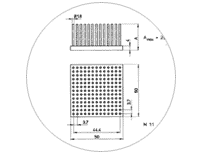|
|
 |
| :: TECHNOLOGY :: |
|
 Electric devices generate heat due to operation processes. Every device has a maximum operating
temperature. The usable life cycle of a device decreases quickly being operated at a higher temperature.
In order to prevent failure the heat must be removed efficiently to the ambient environment.
Electric devices generate heat due to operation processes. Every device has a maximum operating
temperature. The usable life cycle of a device decreases quickly being operated at a higher temperature.
In order to prevent failure the heat must be removed efficiently to the ambient environment.
To disspate the harmful heat the devices are connected to a cooling element, regularly a heat sink.
The performance of a heat sink is definded by:
- the thermal conductivity of its material
- the dimension of the heat dissipating surface
- the mass of the heat sink
- the homogeneity and direction of the microstructure
- the ambient heat capturing medium ( air, water )
Other influencing parameters are:
- speed and temperature of the ambient medium
- the mounting situation and direction
- fastening of the heat sink
- the interface material in application
The most common heat sink technologies are extruded profiles, limited by the two
dimensional setting of forming (silouette, cut-out), and die-casted heat sinks, limited
by the poor thermal conductivity of its material.
 Die-casted pin-fin heat sink are a very common cooling solution in the automotive
Segment. The outperformance by pure-aluminium pin-fin heat sinks was first
stated in a comprehensive basic study by the Technical University of Aachen the
Institut ISEA under Prof. Rik De Doncker.
Die-casted pin-fin heat sink are a very common cooling solution in the automotive
Segment. The outperformance by pure-aluminium pin-fin heat sinks was first
stated in a comprehensive basic study by the Technical University of Aachen the
Institut ISEA under Prof. Rik De Doncker.
The thermal conductivity of pure aluminium ( > 220 W/ms ) as well as the new
processing technology show a clear higher performance to casted as well as
extruded heat sinks. For circumstances of natural convection as well as for
set ups of forced convection.
A guideline for a comparative improvement to thermal performance could be:
+ 40 % to die-casted heat sinks
+ 30 % to extruded heat sinks
+ 15 % to forged heat sinks
|
|